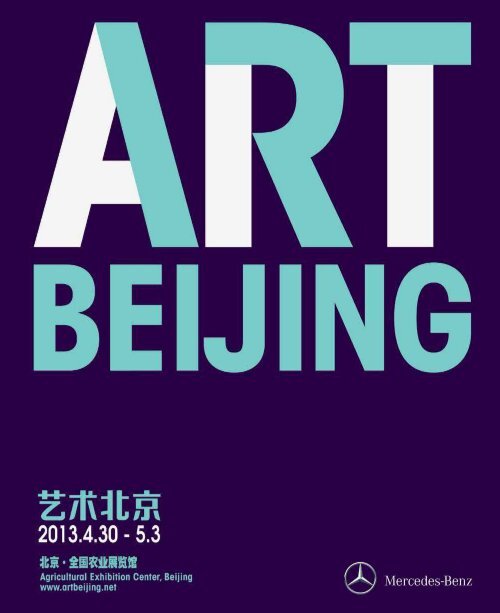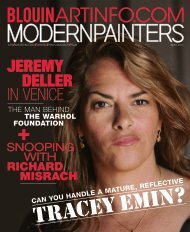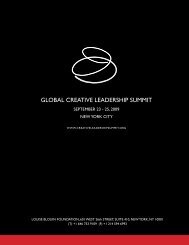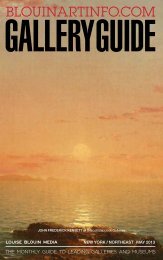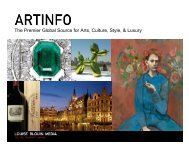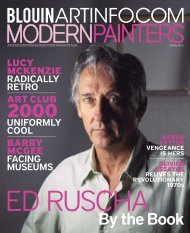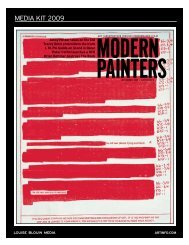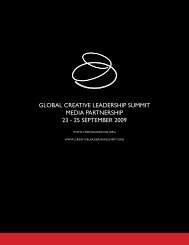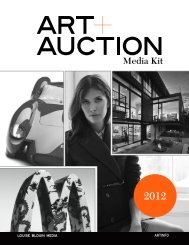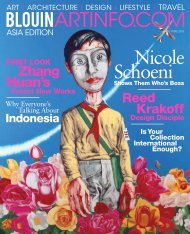Linke - Artinfo
Linke - Artinfo
Linke - Artinfo
You also want an ePaper? Increase the reach of your titles
YUMPU automatically turns print PDFs into web optimized ePapers that Google loves.
CLOCKWISE FROM UPPER LEFT: LEE KA-SING AND KAI CHAN; TWO IMAGES, SHOJI FUJII AND YIQING YIN.<br />
The Sculptural Couture<br />
of Yiqing Yin<br />
A French designer shapes fabrics on<br />
the body body to create soft feminine armor<br />
By Sonia Kolesnikov-Jessop<br />
YOUNG FRENCH COUTURIER Yiqing Yin<br />
has found rapid success since she<br />
launched her first collection in 2010. That<br />
year, she presented her creations at the<br />
prestigious Hyères International ternational<br />
Festival, won the Grand Prix of Creation<br />
awarded by the City ty of of Paris, and and saw<br />
her her designs designs displayed in in the the windows of of<br />
the Culture Ministry and at the Théâtre<br />
National de Chaillot. The e following year,<br />
her her second second collection, collection, the Dreamer, Dreamer, was<br />
exhibited at the Hôtel de Crillon illon during the March 2011 Women’s Women’s<br />
Fashion week curated by Vogue Paris. A A few months later, she<br />
was awarded the Andam Prize for First Collections. Then en in<br />
2012, she debuted as an invited guest during Haute Couture uture<br />
Fashion Week in Paris and successfully launched a readyreadyto-wear collection internationally. I recently recently sat down with the<br />
27-year-old 27-year-old designer for a discussion about her practice.<br />
A lot of your designs are very sculptural.<br />
Have you studied art?<br />
I studied arts and crafts at the École Nationale tionale Supérieure des<br />
Arts Décoratifs for five years. We did many things, from<br />
sculpture and stage design to graphic design and photography.<br />
We studied space, objects, and images all together through<br />
different forms of expression. I always loved the sculptural<br />
element. Sculpture is very important when you put it in situ; it<br />
comes with the space surrounding it. That’s at’s very important. important.<br />
And I see fashion as a way of sculpting on a living body as a<br />
support, using fabric as a medium. But it is something that is<br />
always moving, so it ’s ’s movement within a space and it needs to<br />
relate to its environment. It’s ’s a moving sculpture, and the<br />
movement and the imprint that the body body leaves leaves behind as it<br />
moves—the grace, the the body body language—is all part of of the final<br />
result. In a way, I have the original idea but it ’s actually the<br />
person who wears the garment who finishes it.<br />
What was the starting point for your Spring-Summer<br />
2013 collection?<br />
The e thread, the line, and the unweaving motion of matter were were<br />
the starting point. My mood mood board was dark, muted, and austere,<br />
with pictures of sculptures by the Russian artist Naum um Gabo,<br />
who sculpted ethereal, hyperbolic volumes out of thread<br />
without ever invading the space. I was also influenced by thread thread<br />
sculptures by the artist Kai Chan. There ere were also bondage<br />
Blouin<strong>Artinfo</strong>.comAsiA | MARCH/APRIL 2013<br />
artonthecatwalk<br />
Above, two designs<br />
from the Spring-<br />
Summer 2013<br />
couture collection<br />
by Yiqing Yin, who<br />
cites the influence<br />
of Russian sculptor<br />
Naum Gabo<br />
(1890–1977) and<br />
contemporary<br />
Canadian artist Kai<br />
Chan, whose 2012<br />
silk thread installation,<br />
Scent of Roses,<br />
is at upper left .<br />
The Art of Living


